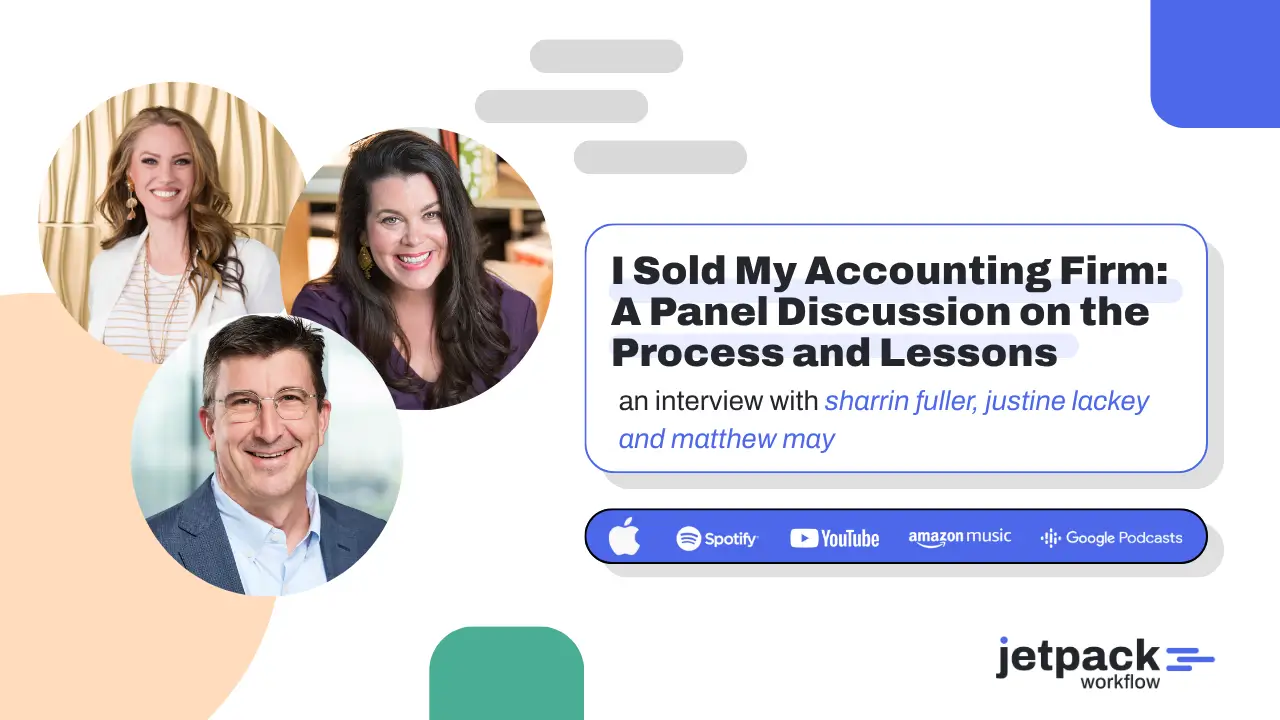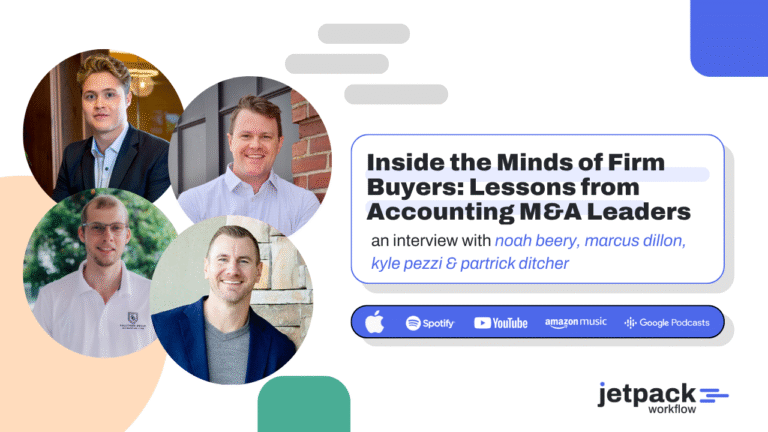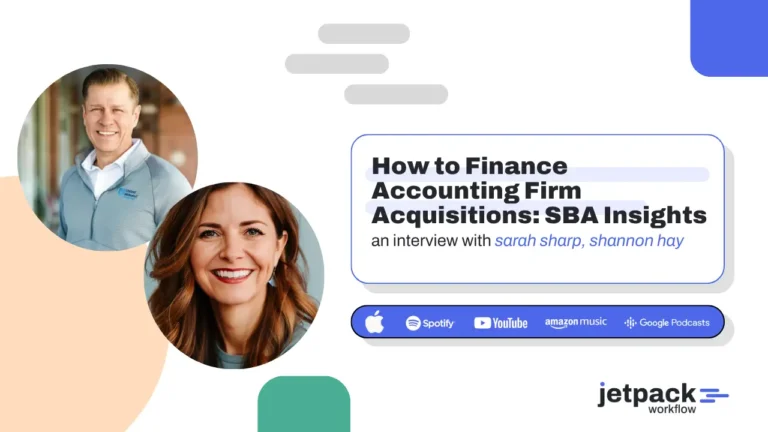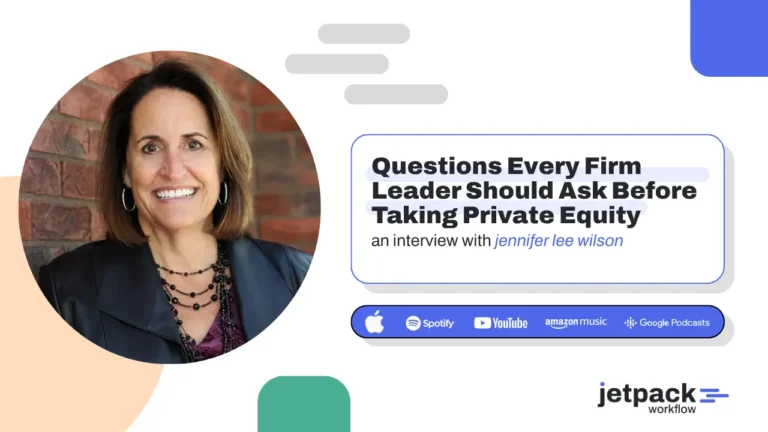I Sold My Accounting Firm: A Panel Discussion on the Process and Lessons

Selling a firm is more than a transaction. It is a test of timing, structure, and self-awareness. In this M&A Summit panel, three accounting entrepreneurs, Sharrin Fuller, Justine Lackey, and Matthew May, shared why they sold, what they learned, and how they approached life after the sale.
Featuring insights from Sharrin Fuller, Justine Lackey, and Matthew May at the Jetpack Workflow M&A Summit
Key Takeaways
- Many firm sales begin after milestone moments such as turning 50 or hitting a major revenue goal.
- Hiring a trusted broker or investment banker can reduce chaos and clarify real opportunities.
- Transparency and timing matter, as telling staff too early or too late can disrupt the deal.
- Post-sale alignment and communication are essential to keep clients and employees confident.
- Owners who plan for what’s next after the sale experience smoother transitions and greater fulfillment.
Why They Decided to Sell
Each owner reached a different turning point, but all faced a moment when continuing alone no longer made sense.
Matthew May, co-founder of Acuity and National Accounting Managing partner at Sorren, explained that milestone moments triggered reflection.
We turned twenty as a company, and all four owners turned fifty. That made us ask what the next decade should look like.”
With growth past the ten million dollar mark and daily buyout offers arriving, his team hired an investment banker to evaluate all options. After a nine-month process, they chose a private equity rollup.
Justine Lackey, founder of Good Sense Bookkeeping, reached her inflection point through both burnout and perspective.
I’d been doing this for thirty years. I asked myself, is this what I want to do for the rest of my life?”
After a difficult staffing issue and renewed clarity about her goals, she began serious buyer discussions that led to a successful 2023 sale.
For Sharrin Fuller, founder of multiple virtual firms, the decision came earlier in life but under the same strain.
It was pure burnout. I grew too fast, hired too quickly, and realized the business was running me.”
She sold her first firm in 2021, stayed briefly under a board, then rebuilt, merged, and prepared a second sale two years later.
How They Prepared
All three emphasized one theme: intentional preparation.
May described a disciplined process guided by bankers who contacted more than two hundred potential acquirers before narrowing the list to eleven serious groups.
When the real offers came in, that’s when alignment happened. Each partner had to decide what they personally wanted before choosing any deal.”
Lackey worked with a broker who filtered out unqualified buyers.
Your broker should protect your time. Mine had a detailed onboarding process and only brought serious candidates.”
Fuller learned to fix what had cost her time and stress the first time around.
I made sure my client contracts were transferable and my systems ran without me. The first time I had to get every client’s signature to sell, and it nearly broke me.”
Lessons from the Sale Process
-
Put Everything in Writing
Fuller warned that enthusiasm in Zoom meetings means little without legal documentation.“If it isn’t in writing, it won’t happen.”
-
Tell Your Team Carefully
Announcing a sale too early can spark fear. Fuller experienced staff departures in her first sale and waited until closing the second time. -
Vet Your Advisors
Each panelist credited their attorney or broker as essential. May’s bankers guided alignment, and Lackey’s long-time attorney helped her structure a smooth transition. -
Expect Emotional Whiplash
Lackey compared selling to “the hokey pokey.”“You put your right foot in, then out again. It’s exhilarating and terrifying at the same time.”
Technology Choices and Efficiency
Efficient systems made each firm more attractive to buyers.
Lackey ran fully on QuickBooks Online and built standardized client workflows using Harvest, ShareFile, G Suite, and password management tools.
May used a home-built stack integrating Process Street, Salesforce, Zapier, Airtable, and PandaDoc, later consolidating under Karbon for practice management.
Fuller used Client Hub for communication and files, Google Workspace, Rippling for HR, and QuickBooks Online exclusively, supported by extensive Zapier automations.
Each confirmed that focus and consistency outweighed variety. Simpler stacks eased transitions and boosted valuations.
What Happened After the Ink Dried
May described the human side of integration after selling to a private equity group.
“Day one through four, I was on the phone convincing every employee they still had a job.”
With fourteen firms under one umbrella, he spent weeks visiting offices, aligning cultures, and building a shared CAS structure for the future.
Lackey experienced a completely different post-sale life.
“Fifty-seven days after selling, my father had a heart attack. Having the time, freedom, and money to be there for him was a blessing.”
She also learned a practical lesson: keep personal QuickBooks files separate from client accounts to simplify ownership transfers.
Fuller learned her biggest lesson through the restrictions in her first contract.
“I couldn’t touch accounting for six months, couldn’t start a firm for four years, and couldn’t contact clients for ten. I’ll never sign that again.”
Her second deal was smoother and designed to let her exit quietly while her director of operations took over.
Parting Advice for Firm Owners Considering a Sale
Hire an M&A attorney early. Fuller stressed legal review above all else.
“Go to someone who has been through it. You don’t know what you don’t know until you know it.”
Be clear about your purpose. May encouraged intentionality.
“Define what you want from the process, whether it’s debt freedom, succession, or peace of mind, and align every step with that.”
Take your time and protect your legacy. Lackey emphasized values.
“Know the kind of buyer you want. I sold to someone I trusted completely with my clients and my team.”
Conclusion
Selling an accounting firm is not simply a financial event. It is an emotional and strategic milestone that requires clarity, preparation, and the right support team. As Sharrin, Justine, and Matthew each revealed, the process can be rewarding when approached with transparency, documentation, and a clear understanding of personal goals.
Whether you are planning to sell, merge, or simply prepare your firm for future opportunities, the lessons from these founders remind us that success after a sale begins long before the deal is signed. If you’re considering using financing or SBA support during your transaction, read How to Finance Accounting Firm Acquisitions for expert guidance on funding strategies.
Frequently Asked Questions
1. When should an accounting firm owner consider selling?
Most firm owners start considering a sale after hitting personal or business milestones such as turning fifty, facing burnout, or reaching major revenue goals. These moments often spark the question of what comes next.
2. How long does it take to sell an accounting firm?
A typical sale process can take six to twelve months from initial planning to closing. Matthew May’s sale took nine months with the help of an investment banker who managed alignment and offers.
3. What should I include in client contracts before selling?
Add transferability clauses to make your contracts automatically transferable to a buyer. Sharrin Fuller learned this the hard way when her first sale required every client to re-sign, slowing down the entire deal.
4. Should I tell my staff about a potential sale early?
Timing is key. Announcing too early can cause panic, while waiting too long may create mistrust. Involve key leaders early, but communicate with the full team only once the deal is certain.
5. How do I prepare emotionally for an exit?
Selling a firm can feel like losing part of your identity. Have a plan for life after the sale, whether that’s mentoring, consulting, or taking time with family. As Justine Lackey shared, “Know where you’re headed next, not just what you’re leaving behind.”
Streamline Your Firm’s Growth After an Acquisition with Jetpack Workflow
Ensure a smooth post-acquisition transition with Jetpack Workflow. From client onboarding to task automation, our platform keeps your team aligned and productive as you scale.





